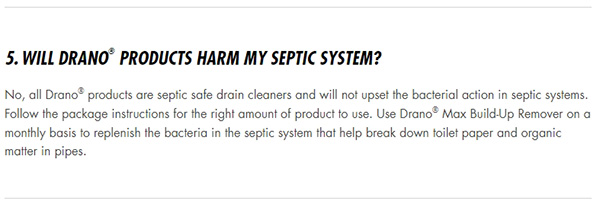Can I use Drano if I have a Septic System?
Ask ten people the best way to clear a clog in your sink or toilet and you'll get at least eleven different answers. Homeowners with septic tanks must also consider whether their unclogging method will interfere with the bacteria in their septic system. Here, too, confusions and conflicting information abounds. Is it safe to use Drano if you have a septic tank? What about dish soap, vinegar, or chemical decloggers that claim to be less caustic than Drano? Check out the product labeling and website and you'll see statements that Drano is safe for use in septic systems, but many experts disagree. Craig Mains, Engineering Scientist at the National Environmental Services Center, definitively states "Using commercial chemical drain openers to unclog drains is not recommended for homes that are on septic systems." He explains that septic systems rely on beneficial bacteria and other microorganisms to decompose the organic components of the wastewater. Harsh chemicals can kill those microorganisms and decrease the effectiveness of the system.  If Drano and other commercial chemical products to unclog drains are off limits to homeowners with septic systems, what alternatives can they use? Often just using a standard plunger is sufficient to clear the clog. Note that bathtubs often have an overflow hole that needs to be covered by a washcloth (or something similar) before plunging. If plunging doesn't work on its own after a dozen or so vigorous pushes of the plunger, Mains recommends trying a mixture of baking soda and vinegar as a natural method of breaking up the clog. Use one cup of baking soda and one cup of vinegar mixed with two quarts of boiling water. Be sure to flush the mixture out with more water after about fifteen minutes of use. There are also commercial unclogging agents that claim to be natural products, but these are harsher than the baking soda and vinegar mixture and don't work any better, so Mains recommends sticking with the mixture above. Homeowners can also try a drain auger or a snake either before or after the baking soda and vinegar application. These implements are designed to physically break up the clog and may be effective on grease, oil, human waste, or other semi-solid products. All of these methods are appropriate for clogs in any location within a house kitchen drains, bathtubs or showers, bathroom sinks, and toilets are all fairly similar when it comes to clogs. Grease and oil clogs are particularly common in kitchen sinks and may react differently to treatments than clogs caused by other materials, but the treatment should be the same. Also, households with small children may experience clogs caused by small toys dropped into the toilet whereas these items won't fit down drains. Preventative measures can be taken to minimize or eliminate the need to unclog pipes and drains. Use strainers on the drains in tubs and showers to prevent hair from falling into the pipes. Avoid putting oils and grease into the kitchen sink. Scrape bacon grease or other cooked-off fats into a separate sealed container and dispose of it with your standard trash pickup. Wipe cooking pans with a paper towel which can also be thrown into the normal trashcan. |
|
Copyright 2007-2026 Septic
Septic.com is provided "as is" and without warranty of any kind, either express or implied, including, but not limited to, the implied warranties of merchantability, fitness for a particular purpose, or non-infringement. |
